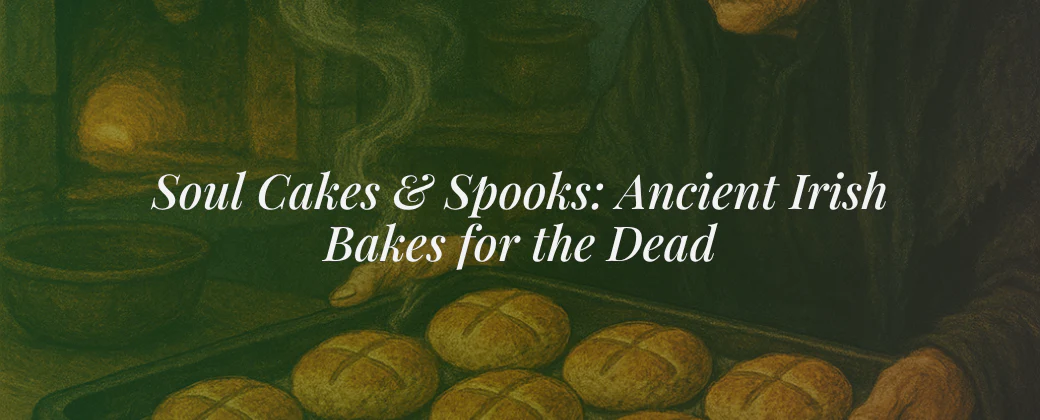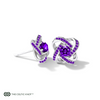Soul Cakes & Spooks: Ancient Irish Bakes for the Dead

Ireland has a long memory. It remembers its dead with candles, prayers, stories and yes, even baked goods. Long before Halloween became the costume-and-candy frenzy we know today, the Irish honored the dead with Soul Cakes, small round treats with big spiritual meaning.
These humble little bakes somewhere between a shortbread, a scone, and a prayer were left out for spirits, given to the poor, or carried door to door by children who once “souled” instead of trick-or-treating.
So grab a mug of something warm, because we’re diving deep into the delicious (and eerie) world of ancient Irish Soul Cakes.
🍂 Where Soul Cakes Came From: A Blend of Pagan & Christian Magic
Soul Cakes didn’t appear out of thin, foggy Irish air. Nope these babies are the product of Samhain, ancestor worship, and early Christian All Souls’ Day traditions blending together.
Originally, during Samhain:
-
The veil thinned
-
Spirits roamed
-
Families honored their dead
-
Food offerings protected the home
When Christianity arrived, rather than stamp out old traditions, it cleverly merged with them. Thus the Soul Cake became:
-
A remembrance food
-
An offering to souls in Purgatory
-
A symbol of charity
-
A sweet way to keep ancient customs alive
They weren’t just a snack they were a spiritual transaction.

👻 Soul Cakes for Spirits: Feeding the Dead
Old Irish households believed spirits wandered freely during Samhain and early November. Some were friendly. Others… not so much.
To keep peace with the unseen, families left:
-
A plate of Soul Cakes
-
A cup of milk or ale
-
A place set at the table
-
Candles in the windows
The idea?
If the dead were fed, they were satisfied.
If they felt ignored… well, they might cause mischief.
Soul Cakes were basically a polite way of saying:
“Hey, spirits, we respect you. Please don’t wreck the place.”
🧒 Souling: The Original Trick-or-Treating
Before kids shouted “trick or treat,” Irish children (and sometimes the poor) went souling.
Here’s how it worked:
-
They knocked on doors
-
Offered prayers for the family’s dead
-
Received Soul Cakes in return
Kind of heartwarming, right?
And just a little creepy.
Souling chants were the ancestors of modern Halloween rhymes. One old version goes:
“A soul! A soul! A soul for a soul cake!
Please, good mistress, a soul cake!”
Fun fact:
Some historians believe Irish and English souling traditions traveled to America and blossomed into trick-or-treating.

🍪 What Soul Cakes Actually Look Like
Picture this:
Small, round, slightly golden cakes.
Spiced with nutmeg or cinnamon.
Buttery, a little crumbly, lightly sweet.
And always always marked with a cross.
Why the cross?
Debate exists.
Possibilities:
-
Christian symbolism
-
A way to “bless” cakes given to the dead
-
A nod to pre-Christian sun symbols
-
A way to help them bake evenly
Whatever the origin, the cross became iconic.
Many modern Soul Cake recipes taste like:
-
A softer shortbread
-
A sweet scone
-
A tea biscuit with spice
Perfect for November nights.

📜 Traditional Irish Soul Cake Recipe
Here’s one you can actually make at home. It's cozy, simple, and full of history.
Ingredients
-
2 cups flour
-
1/2 cup sugar
-
1/2 cup butter
-
1 egg
-
1/2 tsp cinnamon
-
1/2 tsp nutmeg
-
A splash of milk
-
Optional: raisins or currants
Instructions
-
Preheat your oven to 375°F (190°C).
-
Cream butter and sugar together.
-
Add egg and mix well.
-
Add flour and spices.
-
Add milk until the dough holds together.
-
Roll out to ½ inch thick and cut rounds.
-
Mark each with a cross.
-
Bake 10–15 minutes until lightly golden.
Serve warm with tea. And if you’re feeling traditional leave one on the windowsill.
👀 Spooks, Spirits & Superstitions: The Samhain Sidekick
Soul Cakes weren’t just dessert they were part of a bigger supernatural picture.
Irish November was full of:
-
Wandering souls
-
Mischievous fairies
-
The Púca (a shapeshifting spirit)
-
Silent processions of the dead
-
Omens delivered through food, dreams, or flickering flames
It was believed the dead returned not just to visit, but to check on their families. And food offerings kept them happy.
Leave out food = peaceful spirits
Forget to leave anything = ghostly chaos
From broken dishes to restless nights, stories warn of what happens when the dead feel ignored.
❓ FAQs
Were Soul Cakes only Irish?
They were most common in Ireland and Britain but tied specifically to Irish Samhain folklore.
Do people still make Soul Cakes today?
Yes! Pagan groups, Irish families, bakers, and history lovers all keep the tradition alive.
Are Soul Cakes the origin of trick-or-treating?
Many historians believe so souling traditions strongly influenced modern Halloween customs.
Why were Soul Cakes given to the poor?
As a charitable act. In return, the poor prayed for the souls of the giver’s family.
🌟 A Sweet Goodbye to an Ancient Tradition
Soul Cakes may be small, but their story is enormous woven through centuries of Irish spirituality, folklore, food, and family. They remind us that honoring the dead doesn’t have to be grim. Sometimes, it can be warm, fragrant, and sweet.
So whether you bake them for spirits, history, or just a cozy treat, Soul Cakes keep a little piece of Samhain magic alive in every bite.





